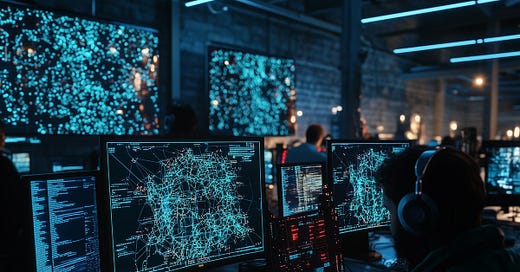What does it mean to respond to polycrisis?
Learnings and reflections from a polycrisis mapping project: Part 1.
What does it mean to respond to polycrisis? Here, we share some learnings and reflections from a research project mapping responses to the polycrisis.
Let’s begin by noting two key concepts: first, as the Cascade Institute argues, the polycrisis is an emergent phenomenon, meaning that it is greater and different in kind than the sum of its parts and therefore needs to be addressed as a whole.1 Second, the concept of a crisis, which consists of the interaction between slow-moving stressors and fast-moving triggers.2
In practice, this brings several questions: first, what counts as a crisis? For example, is climate change a crisis or not? Is everything that is not working a crisis? If so, this seems like a broad definition of crisis.
Second, and most importantly for polycrisis mapping: does an organization need to be tackling specific interlocking crisis triggers and stressors in order to be explicitly a polycrisis response? What does it mean to respond to a crisis, and how is responding to a crisis, or even multiple crises, different from responding to a polycrisis? If an organization only works on one aspect (or one crisis) does that mean it is not responding to the polycrisis?
Looking at an example
Let’s start by looking at one of our examples: Purposeful.3 Purposeful’s main work is transforming ‘the interlocking forces of patriarchy, imperialism and white supremacy’.
They are clearly addressing a deep injustice in our world. But is what they are addressing a ‘crisis’? Or even a polycrisis? Is engaging with underlying power structures addressing a slow-moving and intersystemic stressor and therefore addressing an ingredient of the polycrisis? If addressing any underlying stressor for the polycrisis counts as responding to the polycrisis then we have quite a broad criterion and very many organizations are responding to the polycrisis. However, if we narrow the definition, what are we left with: only those organizations who are explicitly acting on many crises at once? (So maybe the UN?)
Secondly, there may be a difference between underlying stressors that cut through the core of multiple systems and those that sit primarily in one or two. For instance, the Cascade Institute name increased interaction between human and wild-animal gene reservoirs as an example of a stressor in the human-viral ecology system, and chronic healthcare underfunding as a stressor in the healthcare system.4 Is addressing these stressors different from Purposeful tackling social injustice, or Accountability Lab tackling corruption, or Culture Hack Labs tackling harmful cultural narratives?5
A simple 3x3 matrix
In our discussions, we have come up with a framework that might help to clarify some of the questions above. The following 3x3 matrix maps the extent to which an organization is using ‘polycrisis’ thinking against what kind of action they are engaged in. We have roughly categorized the example organizations profiled in this report as well as proposing some example organizations from outside our directory that exemplify some of the other cells in the matrix.
We welcome reflections from readers regarding this matrix and its application, as well as suggestions of example organizations that might fit within cells closer towards the upper-left corner (i.e. more explicitly polycrisis response).
Harms vs Crises
One question we run into when we try to categorize organizations into the above matrix is: what is a crisis?
As the Cascade Institute put it, ‘all crises involve harms, but not all harms arise from crises’.6 In their definition, crisis occurs when a system is pushed suddenly out of equilibrium with harmful consequences.7 But what happens when harmful consequences of a crisis continue to spill out over time? And what about ‘slowly unfolding environmental catastrophes’ such as global heating, deforestation, ocean acidification and more, which have already been described as ‘slow violence’ – do they not count as crises?8
These questions matter because the definition of what constitutes a crisis is a political question: it’s about what collectively we pay attention to and allocate resources towards resolving. As the Cascade Institute note, drawing on the work of Barry Buzan et al.: ‘declaration that a crisis is occurring is often a key step in the securitization of an issue: a problem like cross-border migration or climate change becomes a crisis, and thus a matter of national security not because of its inherent features, but because certain actors convince relevant audiences (generally policymakers) that the issue constitutes an existential threat to the nation and therefore requires responses outside the realm of normal politics’.9
By polycrisis response, do we mean preventing triggers, relieving stresses, or alleviating resultant harm? Do we mean blocking the vectors by which crises can travel within and across systems?10 Another possibility is: removing obstacles to effective intervention.11 These questions matter because they point us towards the question of: where are the most useful places to intervene?
This piece was excerpted with minor adaptations from: Catherine Tran and Rufus Pollock, ‘A Boundary Makes a Map: Reflections from building a prototype directory of actors responding to the polycrisis’ (2023). Read the full report here.
Part 2 will inquire: ‘Does polycrisis call for a “poly” response?’
Lawrence, M., T. Homer-Dixon, S. Janzwood, J. Rockström, O. Renn, and J. F. Donges, ‘Global Polycrisis: The Causal Mechanisms of Crisis Entanglement’ (2023), Version 1.0, Pre-print, Cascade Institute. Downloaded from here.
Lawrence et al., ‘Global Polycrisis’, p.13.
See a snapshot summary of our research on Purposeful in the full report.
Lawrence et al., ‘Global Polycrisis’, p.17.
See the full report for snapshot summaries of our research on these organisations.
Lawrence et al., ‘Global Polycrisis’, p.15.
Lawrence et al., ‘Global Polycrisis’, p.13.
Rob Nixon, Slow Violence and the Environmentalism of the Poor (2011), Cambridge, MA: Harvard University Press, p.2.
Lawrence et al., ‘Global Polycrisis’, p.5.
See Lawrence et al., ‘Global Polycrisis’, p.7 for an explanation of four vectors that can transport a crisis within and across systems.






